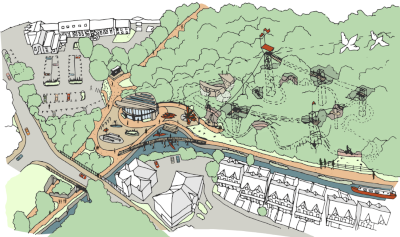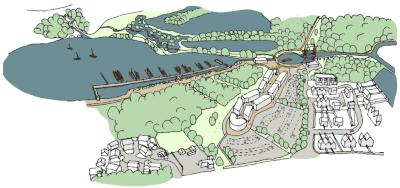A MASTERPLAN to complete the restoration of the Chesterfield Canal as part of a large regeneration project has been launched.
The vision is for the Chesterfield Canal corridor to be reclaimed as a place for the local community to live, enjoy, and be employed; for tourists and visitors to come, play and stay; for new and existing businesses to grow and prosper; and for nature and biodiversity to thrive.
 Two reports
Two reports
About 60 politicians, local government officers, business people, canal enthusiasts and journalists gathered at the Parish Suite in Killamarsh to hear that there are two reports—a high level Strategic Outline Case covering the corridor between Chesterfield and Kiveton Park, and a more detailed Outline Business Case covering the section within North East Derbyshire District Council.
Both reports cover the Strategic, Economic, Commercial, Financial and Management aspects of full restoration. They focus on establishing a framework for the regeneration of the canal corridor rather than just the restoration of the canal itself.
The Chesterfield Canal Corridor Project will provide new canal and water-based training opportunities, introduce a range of activities to attract tourists and local residents, support activities for paddle sports, introduce cycling and walking trails with fitness opportunities to improve physical and mental health, create new business opportunities along the route, develop new car parking and access to improve connectivity, introduce measures to ensure the safety and security of users, support and enhance native wildlife and habitats, and create new areas for biodiversity.
Further enhance the corridor
It will further enhance the corridor as a place to live, visit and do business, improving the viability of housing delivery and raising land values locally to attract a range of economic investment.
 Eighteen different hubs have been identified along the canal corridor. The report provides a summary of each site, some background information, potential project ideas and how they align with the drivers for change which are—Live, Work, Play, Health, Heritage and Environment.The potential financial returns from these drivers include £252 million in Visitor Expenditure, £132 million in Art & Heritage Engagement and £116 million in Job Creation.
Eighteen different hubs have been identified along the canal corridor. The report provides a summary of each site, some background information, potential project ideas and how they align with the drivers for change which are—Live, Work, Play, Health, Heritage and Environment.The potential financial returns from these drivers include £252 million in Visitor Expenditure, £132 million in Art & Heritage Engagement and £116 million in Job Creation.
The masterplan was compiled by Focus Consultants and Sigma Architects. It was commissioned by the Chesterfield Canal Partnership, which is composed of local authorities, statutory and non-statutory bodies, the voluntary sector and private enterprise.
During the research for the project, dozens of different stakeholders were consulted including all the local county, district and borough councils, the Trans Pennine Trail, Cycle Chesterfield, the British Horse Society, the Environment Agency, Don Catchment Rivers Trust, Kiveton Stakeholder Group and Don, Dearne & Rother Network. In addition, a community survey was circulated to Parish Councils along the route of the canal.
Alongside the restoration
The project will be delivered alongside the restoration of the canal itself. The Chesterfield Canal is one of the country’s earliest navigations, opening in 1777. Originally constructed for carrying goods, the commercial traffic on the canal dropped off with the coming of the railways. The canal further declined in the early 20th century, and by 1968 only the 26 miles from Worksop to the Trent were still navigable. Since 1989, through the hard work of those involved, 12 miles of the Chesterfield Canal has been reinstated, along with 37 locks, 12 major bridges and 2 new marinas.
There now remains approximately 8.5 miles of the canal to be restored between Staveley and Kiveton Park to make the canal fully navigable once more.
